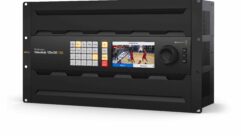Powerless To Change
Some AV products have gone wireless. When will they cut the power cord, too?
The age of fuel cellsWhy cut the cord?What’s inside countsLess bright ideas
ALMOST ALL wireless AV products have one thing in common: They’re not. Regardless of whether a projector or display is getting its signal from 802.11 WiFi or another technology, they’re still tethered to the wall by a power cord.
One hundred years ago, the industrial magnate J.P. Morgan made a decision that may have kept wireless electricity from becoming reality: He abruptly withdrew funding for Nikola Tesla’s research into wireless power. It wasn’t for lack of results. In 1899, Tesla successfully tested a system that wirelessly sent 100 million volts 26 miles, where it lit up 200 light bulbs and powered an electric motor.
Tesla’s technology featured a large sphere that discharged electricity in pulses that were more like longitudinal sound waves than electricity’s normal transverse wave. That innovation meant that power could be transmitted like sound.
Tesla never recovered from Morgan’s withdrawal, and the idea of wireless power more or less died on the vine, except for the occasional layman’s attempt. One of the better-known examples is farmers living near high-voltage lines who bury loops of copper wire underneath to effectively — and successfully — suck the power off of the line. The trick leverages a phenomenon known as induction, which is the electromagnetic field produced by the current flow.
Another recent example of induction is Splashpower, a U.K. company that makes wireless battery chargers for handheld devices. The system consists of a SplashPad, a rubbery, placemat-sized pad that plugs into a wall outlet. The other component is the SplashModule, which is built into handheld devices, such as a PDAs or cell phones. When the device is laid on the SplashPad, the SplashModule effectively sucks power from it to charge the device’s battery.
But when it comes to wireless power for AV gear and other electronic devices, wireless power remains an elusive dream. Today, portable power means using batteries, with their successor — fuel cells — just around the corner. As their name implies, fuel cells convert a fuel such as hydrogen or methanol into electrical power. That conversion relies on chemical reactions, so in that sense, fuel cells are like batteries, except that they generate much more power.
Until recently, the technology has been too bulky and expensive for use in portable devices. For example, in March, UltraCell, a Livermore, CA-based company, announced a 2.2-pound prototype fuel cell capable of powering a laptop computer for 14 hours. The company says that the first commercial versions should debut next year for less than $500.
Fuel cell adoption outside of pro AV is noteworthy for two reasons. First, consumer products ship in much higher volumes than pro gear, so the more fuel cells are sold, the more the price of the technology drops. That increases the chances of making a business case for using fuel cells in AV gear. Second, the more fuel cells are sold, the more revenue that their manufacturers have to plow into R&D to extend the life and power to the point that it becomes practical for use in AV products.
One potential reason for using portable power in a boardroom or classroom is to eliminate the cost of running electrical cable. That can run $100 or more, depending on factors such as distance, difficulty, and whether the new line pushes the building’s electrical infrastructure to the point that something has to be upgraded, such as a breaker panel. From that perspective, the decision comes down to whether there’s a stronger business case for using a cordless power source, such as a fuel cell.
“I’d question whether cordless power would be cost-effective,” says Phil Hale, presentation systems coordinator at Rollins College in Winter Park, FL. “At this point I think most schools have power where they need it in most rooms. The power cell has definite advantages, depending on recharge rates, for emergency operations centers.”
Besides improving the output and reliability of cordless power sources, the quest for truly wireless AV products could be driven by improvements in their components.
“For a projector, the main power consumption is the lamp,” says Jeff Muto, product manager for projectors at ViewSonic, a display products manufacturer based in Walnut, CA. “A processor’s power efficiency is only a concern on products such as LED projectors or USB-related devices, where the power is limited. The main focus on power reduction should be on the light source.”
As a light source, LED technology has several benefits besides low power consumption, such as low heat, long life, and fast start-ups. So if vendors start shifting toward LEDs primarily for the latter three benefits, it would benefit any push for cordless power.
“LED light sources will become the primary focus in the near future,” Muto says. “LED is at the beginning of the technology cycle and will quickly grow in performance.”
One helpful trend under way is that projectors are becoming more efficient. “One lumen per watt used to be considered a typical value,” says Matthew Brennesholtz, senior analyst at Insight Media, a Norwalk, CT-based research firm that tracks the AV market. “For example, the old Talaria projector got about 1,600 lumens (on a good day) out of a 1,600-watt lamp. Modern projectors can do considerably better than that.”
Brennesholtz recently tested eight low-end pro and home theater projectors, and they ranged from 2.2 lumen/watt to 8.2 lumen/watt. “All of the most efficient projectors were 3LCD, and the best DLP projector was 6.8 lumen/watt,” Brennesholtz says.
Yet the quest for brightness is increasing power requirements even as the projectors become more efficient.
“Power requirements have consistently increased for projectors due to higher brightness demands,” says ViewSonic’s Muto. “The demand for DLP has specifically made this true: An LCD projector with the same brightness of a DLP projector typically uses less power.”
Some settings can’t be tinkered with in order to save power, at least not without cutting into performance — and the product’s market potential. “A data projector’s primary sale point is on brightness, and reducing power means reducing brightness,” Muto says. “Unless the market can accept lower-brightness projectors, I don’t believe low power will take off with projectors.”
In displays, one way to reduce power consumption — and thus make cordless power more viable —is to get creative with the mode. That’s what Toshiba Matsushita Display (TMD) did in March, when it announced a prototype LCD laptop display that toggles between progressive scan mode and interlaced scan mode in order to reduce power consumption by 15 to 32 percent compared to a standard TFT-LCD display.
Known as dynamic display power optimization, TMD’s technology automatically chooses the mode based on what’s being displayed. For example, if the user is working on email or a Word document, the display uses interlaced scan mode, which draws less power because the image isn’t refreshed as frequently. If the user closes those applications and pops in a DVD, the display switches to progressive scan mode, which draws more power because the image is refreshed more often in order to provide more detail.
TMD declined to provide more details, including when the technology might be commercially available. Although it appears to be destined for use primarily in laptops, the technology could be viable for certain types of pro AV applications. For example, digital signage running a loop of static images and video could use the technology to reduce power consumption to the point that a cordless power source, such as a fuel cell, would provide enough juice for several days or weeks of operation. A completely cordless display could be a particularly good fit for temporary applications such as trade show booths or mall kiosks, where power may be limited.
Those innovations suggest that truly wireless AV products may finally arrive — albeit several years from now. If so, it would vindicate the vision, if not the technologies of Nikola Tesla, who spent his final 40 years in poverty and discouragement.
A century later, some still take Tesla-style ideas seriously: In November 2002, the American Council for the United Nations University issued a report, Wireless Transmission in Earth’s Energy Future, which concluded that power lines were becoming impractical, especially in urban areas. Their solution: Use a NASA-tested system that converts electricity to microwaves, which satellites beam to terrestrial stations that then convert it back to electricity.
For more information about how AV is cutting the cord, check out:
- Dynamic display power optimization — For more information about Toshiba Matsushita Display’s prototype technology, visit www.tmdisplay.com/tm_dsp/press/2006/06-03-08.html.
- Fuel cells — For more information about how fuel cells work and commercial products available today, see www.fuelcells.org and www.fuelcelltoday.com.
- Nikola Tesla – For more information about the man and his research on wireless power, visit www.teslatech.info/ttmagazine/v1n4/valone.htm and www.teslasociety.com.
- Wireless Transmission in Earth’s Energy Future —More information about the American Council for the United Nations University’s report is available at www.acunu.org/millennium/press.html#energy.
- Splashpower – For more details about the company’s wireless battery chargers, see www.splashpower.com.
- What’s Wrong With Wireless?Unreasonable expectations, technical hurdles, and security issues have prevented wireless projection from going mainstream. Are we any closer to a solution?, May 2005 PRO AV
Tim Kridel is a freelance writer and analyst who covers telecom and technology. He’s based in Kansas City and can be reached at [email protected].










